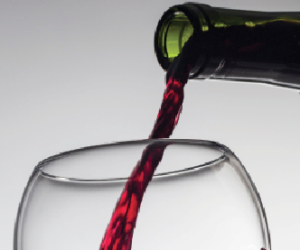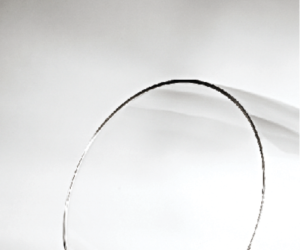In the life of the amateur winemaker, there may come a time when the idea of starting a commercial winery pops up. Making wine can be a gratifying and engaging career, so why not take the plunge and start your own winery? Despite the allure of a winemaking career, getting established can take years and requires considerable resources. I spoke with winemakers in different parts of the country who successfully graduated from home to professional winemaking. According to the five winemakers I spoke with about making the transition from home winemaker to running a self-supporting winery, it can take years to go from the concept of winery to the real thing. Their stories are both uplifting and cautionary.
Vines & Rushes Winery
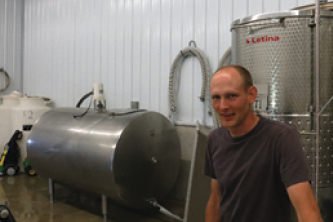
Although Central Wisconsin may seem like an unlikely place to start a winery, the upper Midwest is one of the fastest growing wine producing areas in the US. Federal permit requests to start wineries in Wisconsin increased 18% for the year ending April 30, 2013. From 2005 through 2011, an average of nine new wineries were added each year in Wisconsin.
For Ryan Prellwitz of Vines & Rushes Winery in the central Wisconsin college town of Ripon, starting a winery is a way to take a family tradition in a new direction. Prellwitz grew up in a farming family with 15 acres of strawberries as well as corn and soy.
He spent six years as an amateur winemaker before starting his own winery at age 30. Not surprisingly, Prellwitz’s first wines were made from strawberries. “We obviously had plenty of strawberries to work with so they provided a place to start,” he said.
Before opening Vines & Rushes in January of 2013, Prellwitz worked as a website developer. The attention to detail he honed working with computers carries over to winemaking, Prellwitz believes. While working methodically towards a goal is important, Prellwitz said that starting a winery takes assertiveness. “People have dreams — like having kids — but there’s never a perfect time. Starting a winery is going to change your life no matter what, so you may as well get started. It’s not just a huge financial investment, you also have to make a big personal commitment to realize your goals.”
The cash investment to start Vines & Rushes was substantial: $250,000 for the building and another $60,000 to $70,000 for equipment. (This does not include the cost of planting the four-acre vineyard with cold-hardy grapes.) Having a good relationship with a local bank was critical to being able to start the winery, Prellwitz said.
Like many new winery owners, Prellwitz is managing a complex business with three main divisions; grape growing, winemaking and perhaps most daunting of all, marketing. At a winery, marketing covers everything from running the tasting room to designing labels and logos. Compliance with government regulations is also a vital marketing function that may require outside help.
Prellwitz said that unless a new winery owner can afford full-time tasting room staff, he or she can expect to spend many hours in customer service roles. “People want to interact with the winemaker,” he said. “This includes not only face-to-face communication, but also social media. I spend a lot of time making sure the winery’s Facebook page is up-to-date.”
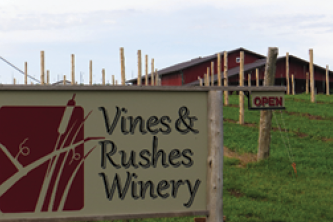
Quality control can be an issue
For start-up wineries, particularly in emerging wine regions. Wineries sometimes open the doors before they have mastered production of flawless wine. Prellwitz said that producing wine in larger volumes requires constant diligence and monitoring.
Gaining the skill set to become a self-sufficient winemaker, which usually requires production of 5,000 to 7,000 gallons (18,927 to 26,497 L) a year, can be accomplished in several ways. Working as an apprentice in a winery is ideal, but this route is not always an option for entrepreneurs. Many areas also have university or community college classes, like the popular Viticulture Enology Science and Technology Alliance (VESTA) educational program.
For Prellwitz, hiring a wine consultant to help with winemaking issues as they arose was not a luxury. “If you don’t know everything right away, you’ll have to hire a consultant,” Prellwitz said.
“Home winemaking and professional winemaking are different and my winemaking consultant helps me with issues as they come up.”
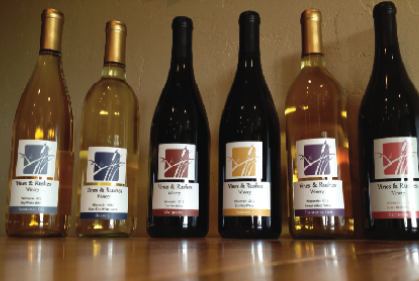
Another type of consultant a new winery may need is a professional designer to develop a special “look” for the business, Prellwitz said. In most parts of the country, just opening winery is no longer enough to create consumer demand. To be successful requires developing a consistent personality for a winery. This image must be conveyed across all aspects of the business, from the architecture of the winery to the style of the label.
The look and feel of Vines & Rushes is “refined rustic” according to Prellwitz. “We worked hard to create a sense of place here,” he said. “We wanted a winery that was in keeping with our surroundings.” One of the design touches throughout Vines & Rushes is the use of hardwood barn lumber which was used to build doors, the tasting room bar and outdoor furniture.
Vines & Rushes was also fortunate to enlist the services of Ralph Colonna of Colonna Farrell, the renowned Napa Valley label artist who has done design work for wineries that include Beringer, Stags Leap, and Rutherford Hill. Farrell, who now lives in the Ripon area, designed the logo for Vines & Rushes as well as some of the winery’s first labels.
Kriselle Cellars

One of the most common former occupations of commercial winemakers is engineering. For Scott Steingraber, owner and winemaker at Kriselle Cellars in White City, Oregon, owning a winery is the logical extension of a successful 23-year career as a civil engineer. Steingraber was the project manager for the new 5,400-foot-long Tacoma Narrows Bridge, which opened in 2007.
“Like engineering, winemaking is a step- by-step process,” Steingraber said. “You may know about acidity and pH, but there’s also an artistic side to winemaking. As an engineer, integrating something artistic in a complex process is very interesting personally. Winemaking appeals to my creative side in an organized way.”
Steinbgraber started making wine 18 years ago in small carboys as a hobby. His passion turned into a, “garage filled with destemmers, basket presses and wooden barrels” according to the winery’s website. Now he operates a destination winery that produces 3,000 cases per year of premium wine.
Steingraber said that he made his transition to professional winemaking over time. While working at the Naval Base Kitsap, a nuclear submarine base in Bremmerton (west of Seattle), he commuted 1,000 miles a week by air to and from the winery. By leaving work in Seattle on Friday and returning on Sunday, and taking all his vacations around harvest time, Steingraber was able to juggle two demanding careers. But Steingraber said that his heart kept leading him back to the winery.
“After a couple of years of working two jobs, I had to make a decision. Do I want to build bridges or do I want to make wine?” So in 2012, Steingraber retired from engineering, opened his tasting room and began, “melding the business into what I wanted it to be.”
Steingraber used his retirement savings to help finance the winery. (His father-in-law owns the 25-acre vineyard.) Before starting the winery in 2007, Steingraber did an elaborate business plan going out 12 years, which he updates every year. New sales and production data are factored into his planning continuously. For the most part, Steingraber said his original projections have turned out accurately.
“You need to fit all the parts and pieces,” Steingraber said of planning and purchases. “You need to always be asking, ‘How much revenue will this new piece of equipment produce?’”
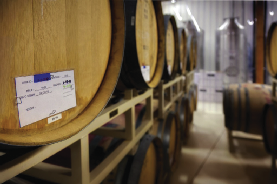
From the outset, Steingraber said his goal was to, “Build a destination winery where wine is the primary focus but also a place where you can enjoy food and the beauty of the vineyards and the surrounding area.” To fulfill this goal, the winery has a pizza oven and his wife, Krisell (no “e” at the end), is in charge of the food component of the winery.
“She does a lot of work coming up with new ways to pair food with our wine,” Scott said.
Kriselle Cellars, like many vineyard-based wineries, is not near a large population center, so the winery depends on tourists for a large portion of its business. Most Kriselle Cellars wine is sold out of the panoramic tasting room. “As a new winery, you may not be in a position to have a distributor who is going to take a large cut,” Steingraber said.
Steingraber said he enjoys the “human aspect” of operating a smaller winery: “It’s satisfying to walk the floor and talk to people in the tasting room. People are happy to be here,” he said.
Kriselle Cellars’ location is dry and warm by Oregon standards. With over 2,500 growing degree days per year, the winery can grow Bordeaux varieties. They also make a Tempranillo that won a gold medal at the Great Northwest Wine Competition.
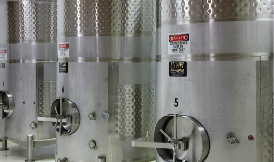
Steingraber added, “To make wine at this level, you need different equipment, but you can move up gradually. I went from carboys to 500-liter tanks at first.”
“You will probably also have to learn to combine different wines. Blending is an art that you have to learn by experience. We blend over and over again. The more you do it, the more it pays off.”
Lastly, Steingraber advises winemakers who are thinking about making a career transition to get as many opinions as possible about their wines. “You are now making wine for your customers, not just for yourself,” he said.
Lawton Ridge Winery
Switching from amateur to professional winemaking involves scaling up your winery. Always think about how much revenue each new piece of equipment can produce before buying it.
One of the most important decisions for any aspiring winery owner is finding the right location. Dean Bender, co-owner of Lawton Ridge Winery near Kalamazoo operates his winery in an area better known for craft beer than wine. Nearby Bell’s Brewery has grown from 135 barrels to 216,000 barrels a year, and just up the road is Grand Rapids, aka “Beer City USA,” with fourteen microbreweries.
“The exploding beer market has been a good thing for us,” Bender said. “The appreciation of the art of brewing and the art of vinification are both part of a fascination with local products that helps regional wineries.”
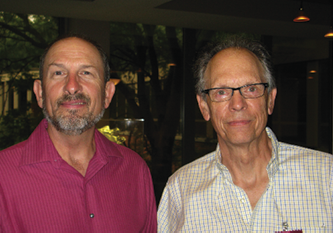
For Bender and his partner Crick Haltom, being “local” means producing their own grapes. Nine miles from the winery, Lawton Ridge has ten acres of grapes, which supply 85% of the juice for their 14 wines. “I think you have a better sense of local identity if you produce the grapes for your wine,” Bender said.
Having control of its fruit supply can be an advantage for a small winery.
Issues with local grape scarcity can be a problem in Michigan and other emerging wine regions.
But being a wine grape producer can be expensive. Planting a vineyard costs around $4,000 an acre in the Midwest. And that’s without the land cost. For Bender and Haltom, investing in a local vineyard, which they eventually purchased outright, was a cost effective way to enter the wine business.
“Crick and I started making wine together back in 1995 when a friend asked us for help bottling his wine,” Bender said. “We were garage winemakers for many years. I was single at the time with a two car garage so that’s where most of the production took place.”
Bender said that the idea of starting a winery simmered for a long time. “As hobby winemakers, we kept asking ourselves, ‘How can we do this full time?’”
Bender and Haltom had ten acres of their own grapes and an idea of the types of wines they wanted to make. But the winery and adjoining tasting room they had in mind required having bottled wine to sell at inception. Building a winery and waiting a year to have a product to sell was not an option financially. So, in 2007, they turned to Fenn Valley Vineyards, one of Michigan’s largest, for help with making their first vintage.
After a year of construction, Lawton Ridge’s tasting room and winery opened in August of 2008 with fully stocked shelves. Over $150,000 was spent on the building and $150,000 more went into the build out of the production area and tasting room, said Haltom who acted as construction manager.
Production at Lawton Ridge last year was 1,700 cases or a little over 4,000 gallons (15,141 L). Production will bump up this year and the winery has the capacity to make 2,000 cases, Bender said. Winning a gold medal at the 2013 Michigan Wine Competition for their Two Handed Red, a Chambourcin blend, has increased demand, Bender said.
Considering that Lawton Ridge opened in the midst of a recession, Bender is happy with the progress the winery has made. “We have paid down the debt and the winery is doing well,” he said.
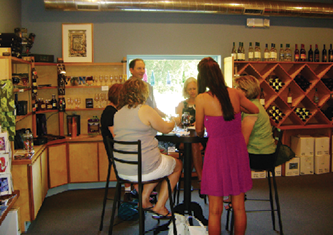
As home winemakers, Bender and Haltom graduated up to producing wine in 100-gallon (379-L) tanks before going commercial. Bender said that one big difference between a commercial winery and a hobby winery is managing and producing many different types of wines.
In their home winemaking days, they made four varieties, two whites and two reds. Bender believes that a commercial winery needs a broader product line to succeed, however, so Lawton Ridge now has 14 different wines in a range of styles for most palates.
Bender also feels that a new winery needs to support people with curious palates. “We make what we grow — we’re not apologetic about being who we are,” he said. Over the years, wine production at Lawton Ridge has gone from mainly hybrid wines to primarily vinifera wines. The two main hybrid wines still in production at Lawton Ridge are Seyval Blanc and Vignoles.
Both Haltom and Bender agree that Lawton Ridge would not have been possible without a combined effort. “Having a partner is big advantage,” Bender said. “If you’re going out on your own, give serious thought to how you are going to make it work.”
Haltom’s advice for those thinking of starting a winery: “It’s a lot of work and the return does not come quickly; if you need income now, you are probably going to need an outside investor.”
Eight Bells Winery
Tim Bates has sailed all over the world as a research chemist for the National Oceanic and Atmospheric Administration (NOAA) studying the effects of particles on climate change. Bates is no stranger to adventure, but he says that nothing can prepare someone for the experience of starting a winery.
“No matter what you know now, it will never replace that experience of actually having done it,” Bates said. “Going from 50 cases in your garage to 500 cases is a huge step. You’ll be dealing with considerably more weight; working with large tanks, barrels and big containers of grapes is much different than home winemaking.”
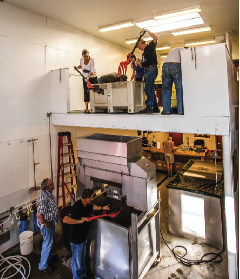
Bates started Eight Bells Winery in Seattle during 2009 with two partners; Andy Shepherd and Frank Michiels. All three partners have equity in the business, although the other two partners are retired from their original careers. They all started by making wine in their garages. For many years, they would go from garage to garage helping each other.
According to Bates, around 2008 the partners started thinking, “You know, one of these days we should start a winery. And if we’re going to do it, we had better do it soon.”
Bates and his partners self financed the winery. Capital investment in the business was not limited to just the initial phase of development, Bates said. “It took about three years before we were no longer cutting any checks to pay for things around the winery.”
Eight Bells is one of 14 wineries on the Seattle Urban Wineries wine trail. Like most new wineries, Eight Bells had to go through a lengthy local approval process. “Our city permit was approved literally as the truck was pulling up with our first grapes,” Bates said.
By choice, Eight Bells does not grow grapes. Bates said their business model allows them to experiment with different vineyards and concentrate on winemaking. “We can tell a grower, ‘this is the style of wine we want and this is how we want our fruit farmed, picked and delivered.” Eight Bells sources grapes from several places including Yakima Valley Washington and western Oregon.
Eight Bells buys grapes by the acre, not the pound, as is the normal practice. Bates said buying grapes by the acre aligns the incentives of the winery and the grower because there is no reason for the grower to over crop or deliver anything but the best fruit.
New wineries can expect the best grape growers to be selective about the wineries they work with, Bates said. “If you’re not growing grapes yourself, you will have to break into the grape market,” Bates said. “Convincing the best growers that you can make quality wines from their grapes has to happen before they will sell to you.”
Production is about 1,500 cases a year, plus or minus a few hundred cases due to variations in grape yields. Bates said that the original business plan projected that wine sales would be one-third white wine and two-thirds red. “It turns out that we are actually selling about 90% red,” Bates said. “We had to adapt our business to what our customers like. As commercial winemakers, we are in the business of pleasing customers.”
As a resident, Bates is very attuned to the profile of his eclectic University District customers. (He lives one half mile from the winery.) “We get tremendous support from the neighborhood,” Bates said. “People here think of Eight Bells as their neighborhood wine. The neighbors even help to bottle our wine since we don’t have a bottling machine. We’ve had about 150 people volunteer so far.”
Eight Bells Winery has a nautical theme with a large wooden ship’s helm on the wall of the tasting room. Two of three partners, including Bates, have sailed across the equator. (The term “eight bells” refers to a standard four-hour sailor’s deck watch. The ship’s bell rings eight times — once each half hour — during a sailor’s four-hour shift.)
The winery is in the space of a former woodworker’s shop. “The space had a lot of electric capacity and some beautiful trim and woodwork,” Bates said. “But it did not have the proper drains or even a bathroom.”
When the space next door to the winery became available last year, Bates said there was a debate within the partnership about expansion. “We decided not to expand,” Bates said. “The biggest consideration for not expanding was maintaining a high level of quality.”
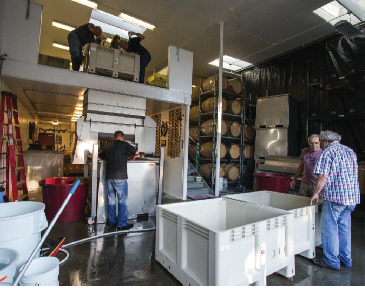
A substantial investment has been made to purchase equipment to make top quality wine, Bates said. He has a PhD in chemistry, so as one might imagine, Eight Bells has a first class wine lab. “We have a wine lab that would rival wineries many times our size,” he said. “For example, we can determine the nitrogen levels in our must and decide how much nutrients we need to add
Bates advises home winemakers to consider that larger commercial-scale fermentations create a lot more heat. “As home winemakers, we had a spare refrigerator that we’d put our carboys in when we needed to slow things down,” Bates said, adding. “We obviously can’t do that anymore.”
Eight Bells did not have temperature-controlled fermentation in the first year of operation. Bates said that this was a problem, especially for the white wines. Now the winery has a glycol cooling system that can ferment the white wines at about a degree of Brix per day. “The aromatics are much better when you’re not blowing them off at high temperatures,” Bates said.
Going from home winemaking in carboys to making large tanks of wine can be stressful at first, Bates said. “At some point you will ask yourself, ‘how many thousands of dollars are in this vat?’ I really hope that I don’t screw it up.”
Like all the winemakers that I spoke with, Bates loves his work and is passionate about making wine. His advice to home winemakers with aspirations of starting their own label: “Go for it! It’s lots of fun. Decide how big a step you want to make at first. But remember that you’ll be spending a lot of time with your local government on permits and paperwork.”



